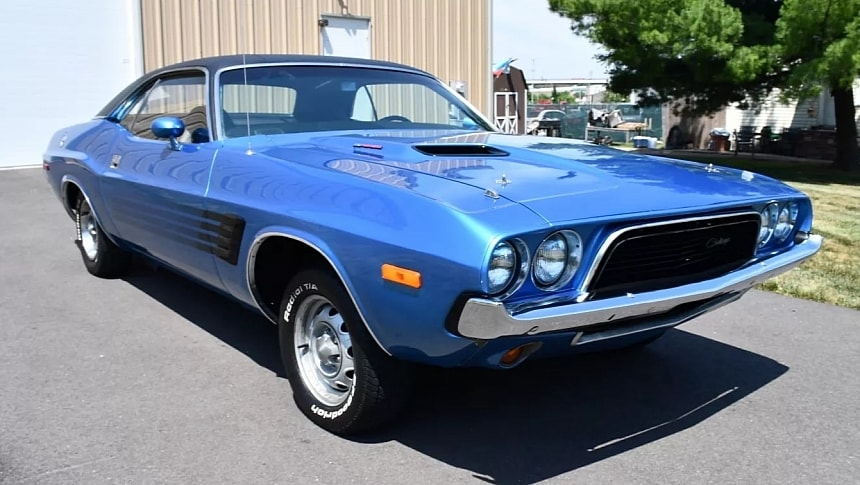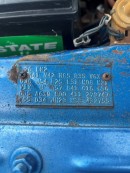Introduced in 1964, the Plymouth Barracuda got a major redesign in 1967. Three years later, the company debuted the third-generation model on the brand-new E-body platform. The latter also prompted Dodge to develop a brand-new muscle car, the Challenger.
Slotted between the compact Dart and the midsize Charger, the Challenger was quite the looker. And its sleek and sporty design was backed by an engine lineup that included Chrysler's most potent V8 engines. No fewer than five big-block powerplants were available in 1970, with output ranging from 275 to 425 horsepower. The 440-cubic-inch (7.2-liter) Six-Pack and the 426-cubic-inch (7.0-liter) HEMI were the superstars of the options list.
But that didn't last long. The muscle car market had already begun to fade in 1970 due to new emission restrictions. Chrysler discontinued its high-compression V8 engines at the end of 1971, ending the Challenger's stint on the muscle car market after only two years. The nameplate remained in production through 1974, but post-1971 Challengers were rather mundane performance-wise.
That's the main reason why the 1970 and 1971 versions are more popular, while the 1972-1974 cars don't get much attention these days. But even though the post-1971 Challenger lacks the oomph of its predecessors, that's not to say these late first-gen Mopars are underpowered. The 340-cubic-inch (5.6-liter) and 360-cubic-inch (5.9-liter) small-block V8s still gave the Challenger more than 200 horsepower from 1972 to 1974.
The 340 four-barrel became the range-topping mill in 1972 and retained its status in 1973. It delivered 240 horsepower. In 1974, the Challenger's final year on the market, it was replaced by the 245-horsepower 360 V8. These units are also notably rarer than the 318-cubic-inch (5.2-liter) V8, which came standard from 1972.
Dodge sold more than 30,000 Challengers in 1973, but only 8,435 units were optioned up with the 340-cubic-inch V8. The blue hardtop you see here is one of those cars. Also equipped with a three-speed automatic, this Mopar is one of 6,480 examples of this drivetrain combo. Not exactly rare, but it doesn't really matter. This Challenger has more important things to brag about.
For starters, it packs a numbers-matching drivetrain. It's not a fully-fledged survivor, but according to the owner, it retains 90% of its components. The car was most likely repainted at some point, but the E5 Blue paint is accurate to the vehicle's factory specifications. The interior, on the other hand, is original and appears to be in fantastic condition for a 50-year-old classic. There's no info on whether the 71,087-mile (114,403-km) reading on the odometer is authentic or not.
Granted, this 1973 Mopar is not as glamorous as a 1970-1971 HEMI or Six Pack, but it's a good option for joining the muscle car world. And it probably won't break the bank, either. The no-reserve listing is at $23,100 with three days to go, and 1973 Challengers rarely go beyond the $35,000 mark.
But that didn't last long. The muscle car market had already begun to fade in 1970 due to new emission restrictions. Chrysler discontinued its high-compression V8 engines at the end of 1971, ending the Challenger's stint on the muscle car market after only two years. The nameplate remained in production through 1974, but post-1971 Challengers were rather mundane performance-wise.
That's the main reason why the 1970 and 1971 versions are more popular, while the 1972-1974 cars don't get much attention these days. But even though the post-1971 Challenger lacks the oomph of its predecessors, that's not to say these late first-gen Mopars are underpowered. The 340-cubic-inch (5.6-liter) and 360-cubic-inch (5.9-liter) small-block V8s still gave the Challenger more than 200 horsepower from 1972 to 1974.
The 340 four-barrel became the range-topping mill in 1972 and retained its status in 1973. It delivered 240 horsepower. In 1974, the Challenger's final year on the market, it was replaced by the 245-horsepower 360 V8. These units are also notably rarer than the 318-cubic-inch (5.2-liter) V8, which came standard from 1972.
Dodge sold more than 30,000 Challengers in 1973, but only 8,435 units were optioned up with the 340-cubic-inch V8. The blue hardtop you see here is one of those cars. Also equipped with a three-speed automatic, this Mopar is one of 6,480 examples of this drivetrain combo. Not exactly rare, but it doesn't really matter. This Challenger has more important things to brag about.
For starters, it packs a numbers-matching drivetrain. It's not a fully-fledged survivor, but according to the owner, it retains 90% of its components. The car was most likely repainted at some point, but the E5 Blue paint is accurate to the vehicle's factory specifications. The interior, on the other hand, is original and appears to be in fantastic condition for a 50-year-old classic. There's no info on whether the 71,087-mile (114,403-km) reading on the odometer is authentic or not.
Granted, this 1973 Mopar is not as glamorous as a 1970-1971 HEMI or Six Pack, but it's a good option for joining the muscle car world. And it probably won't break the bank, either. The no-reserve listing is at $23,100 with three days to go, and 1973 Challengers rarely go beyond the $35,000 mark.












